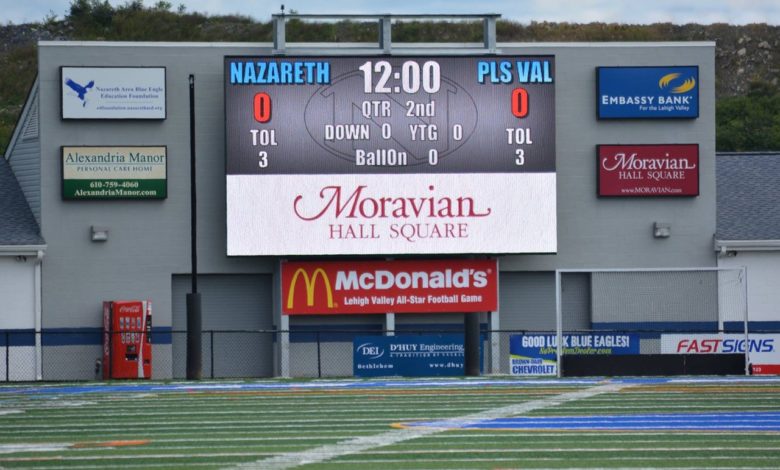
Imagine a stadium with a striking 31′ X 55′ 10mm video scoreboard flashing crowd hype videos, player stats, game highlights, and sponsor ads. Nearby is a press box, concession areas, and indoor training facilities.
No, this isn’t a professional football stadium. Instead, it’s a $34 million high school stadium renovation at Union Public Schools in Tulsa, Oklahoma.
Increasingly, high schools are investing in professional-quality facilities, including large video scoreboards that once were only installed in professional arenas or on large college campuses. These video boards are replacing fixed digit scoreboards in gyms and stadiums across the country.
One reason for the upgrade is the flexibility a video scoreboard brings to a facility. Multipurpose gyms and fields can easily program video boards to display the score for nearly any sport, including basketball, volleyball, football, soccer, lacrosse, baseball, and even marching band competitions.
Once out of reach for most high schools, the cost difference between fixed digit and video scoreboards today often is mitigated through sponsorship opportunities and expanded facility usage.
High schools investing in video scoreboards
Nazareth Area High School, located about 20 miles east of Allentown, Pennsylvania, installed a 15′ X 26′ digital scoreboard and video display in its football stadium manufactured by Watchfire Signs. They balanced the cost by selling ads and brought in nearly $60,000 in advertising revenue in the first six months of operation.
In Danville, Illinois, Danville High School replaced its broken and outdated LED sign in the school’s gym with a 12′ X 7′ 4mm digital video display that is customizable for any sport. Advertisers were thrilled with the new display, and the high school was able to recoup the total cost of the display in the first three months of operation. At the same time, students became proficient at creating content and programming the board.
“We demonstrated that we could help defray the cost of a video scoreboard by having students run the board, create content and sell advertising,” says Mark Bacys, the athletic director at Danville High School.
Early adopters of video board technology often had to purchase expensive switching systems and production software to display live video or instant replay. However, in recent years, the costs associated with deploying this technology have been greatly reduced.
In fact, quality video board manufacturers often offer complementary software that delivers scoring and timing features for multiple sports, allows schools to show live video and instant replays, delivers colorful animated crowd prompts, and can be divided into special screen zones for advertising space.
Enid Public Schools in Enid, Oklahoma, recently installed a 19′ X 35′ video board at David Allen Memorial Ballpark. The facility is home to Enid High School baseball and hosts more than 400 games a year, including the high-profile National Junior College Athletic Association Division II Baseball World Series.
Because of the new video board’s flexibility, the City of Enid is considering hosting outdoor movie nights using the board and is looking into hosting outdoor concerts catering to the entire community.
The ability to leverage video scoreboards beyond sports also appealed to Union Public Schools as the district planned its stadium renovation.
“We felt it was important to serve all 16,000 students and the community with this stadium, not just football players and student-athletes,” adds Lee Snodgrass, executive director of special projects for Union Public Schools.
When the stadium’s renovation is complete in 2022, it will be home to varsity, junior varsity, and youth football leagues, as well as the high school’s marching band. In addition, the district plans to use the stadium for non-sports events, including hosting movie nights and concerts, such as Tulsa’s Reggaefest.
Once just for professional and college sports, video scoreboards are now being embraced by K-12 schools as a way to energize and unite the community, support tourism efforts, and teach students new skills. The ability to generate sponsorship revenue to offset or cover the cost of the scoreboards is an important bonus.



